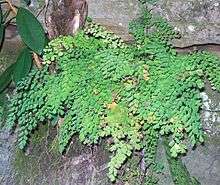Adiantum aethiopicum
Adiantum aethiopicum, also known as the common maidenhair fern, is a small fern of widespread distribution, occurring in Africa, Australia, Norfolk Island and New Zealand.[1]
| Maidenhair fern | |
|---|---|
 | |
| Maidenhair fern at Ferndale Park, Chatswood West, Australia | |
| Scientific classification | |
| Kingdom: | Plantae |
| Clade: | Tracheophytes |
| Class: | Polypodiopsida |
| Order: | Polypodiales |
| Family: | Pteridaceae |
| Genus: | Adiantum |
| Species: | A. aethiopicum |
| Binomial name | |
| Adiantum aethiopicum | |
| Synonyms | |
| |
Adiantum aethiopicum was one of the many species first described by Linnaeus, in this case in his Systema naturae in 1759.[2] The specific epithet aethiopicum in this sense was the Latin term for Africa south of the then known world, that is to say, more or less Africa south of Egypt.[3][4] In South Africa the species occurs widely, though not generally profusely, mainly on moist sandstone cliffs in full shade. In the Cape Peninsula it is uncommon and grows mainly at the highest locally available altitudes, generally about 600–1,085 m (2,000–3,600 ft).[5]
Adiantum aethiopicum grows in spreading clumps of fronds from 10 to 45 cm (4 to 18 in) in height. The rhizomes are wiry and branched. The fronds are horizontal and layered, or upright. They are divided into two or three and have many small wedge-shaped segments, each of which has sori along its margins underneath.[3]
A common plant, often seen growing in moist areas. In Australia it is found near by creeks or in open forest, where it may form a large colony.[6]
The 1889 book 'The Useful Native Plants of Australia’ records that "This plant is said to possess medicinal properties, being slightly astringent and emetic. It has been used in Europe in making "Sirop de Capt'llaire," a demulcent drink, employed in diseases of the chest."[7]
Cultivation
Adiantum aethiopicum is a popular and well known ornamental plant. Propagation is from plant division or by spores.[8] In cultivation the Maidenhair fern prefers a well-lit situation inside, but a shady place outdoors without draughts. It is suitable for terrariums and hanging baskets.[9] It is fairly easy to grow.[10]
| Wikimedia Commons has media related to Adiantum aethiopicum. |
References
- "Adiantum aethiopicum". Flora of Australia Online.
- "Adiantum aethiopicum L." Australian Plant Name Index (APNI), IBIS database. Centre for Plant Biodiversity Research, Australian Government.
- Elliot, Rodger W.; Jones, David L.; Blake, Trevor (1985). Encyclopaedia of Australian Plants Suitable for Cultivation: Vol. 2. Port Melbourne: Lothian Press. p. 158. ISBN 0-85091-143-5.
- Marchant, J.R.V.; Charles Joseph F. (1952). Cassell's Latin dictionary. London: Cassell.
- Roux, J.P. (1979). Cape Peninsula Ferns. Kirstenbosch: National Botanic Gardens of South Africa. ISBN 0-620-03775-X.
- "Adiantum aethiopicum". PlantNET - NSW Flora Online. Retrieved 2010-07-17.
- J. H. Maiden (1889). The useful native plants of Australia : Including Tasmania. Turner and Henderson, Sydney.
- Cundall. P., (2008) Native Plants:The definitive guide to Australian plants, Global Book Publishing Lane Cove, N.S.W, page 278, ISBN 978-1-74048-027-7
- Ratcliffe, David & Patricia (1987). Australian Native Plants for Indoors. Crows Nest, NSW: Little Hills Press. p. 32. ISBN 0-949773-49-2.
- Hambrett, Jo (August 2003). "Summer iii he garden". Garden Design Study Group Newsletter. Australian Native Plants Society (43): 12. ISSN 1039-9062.